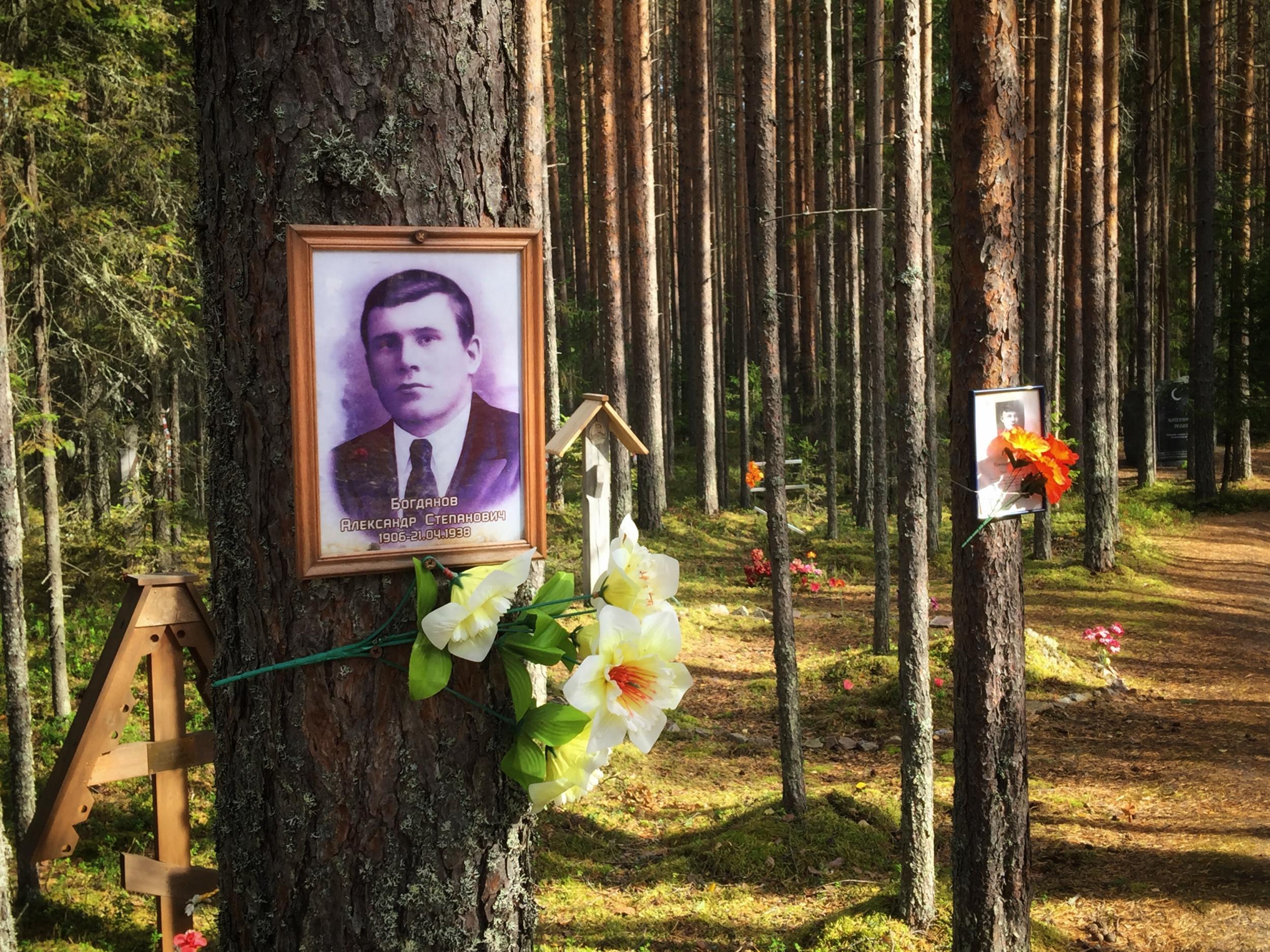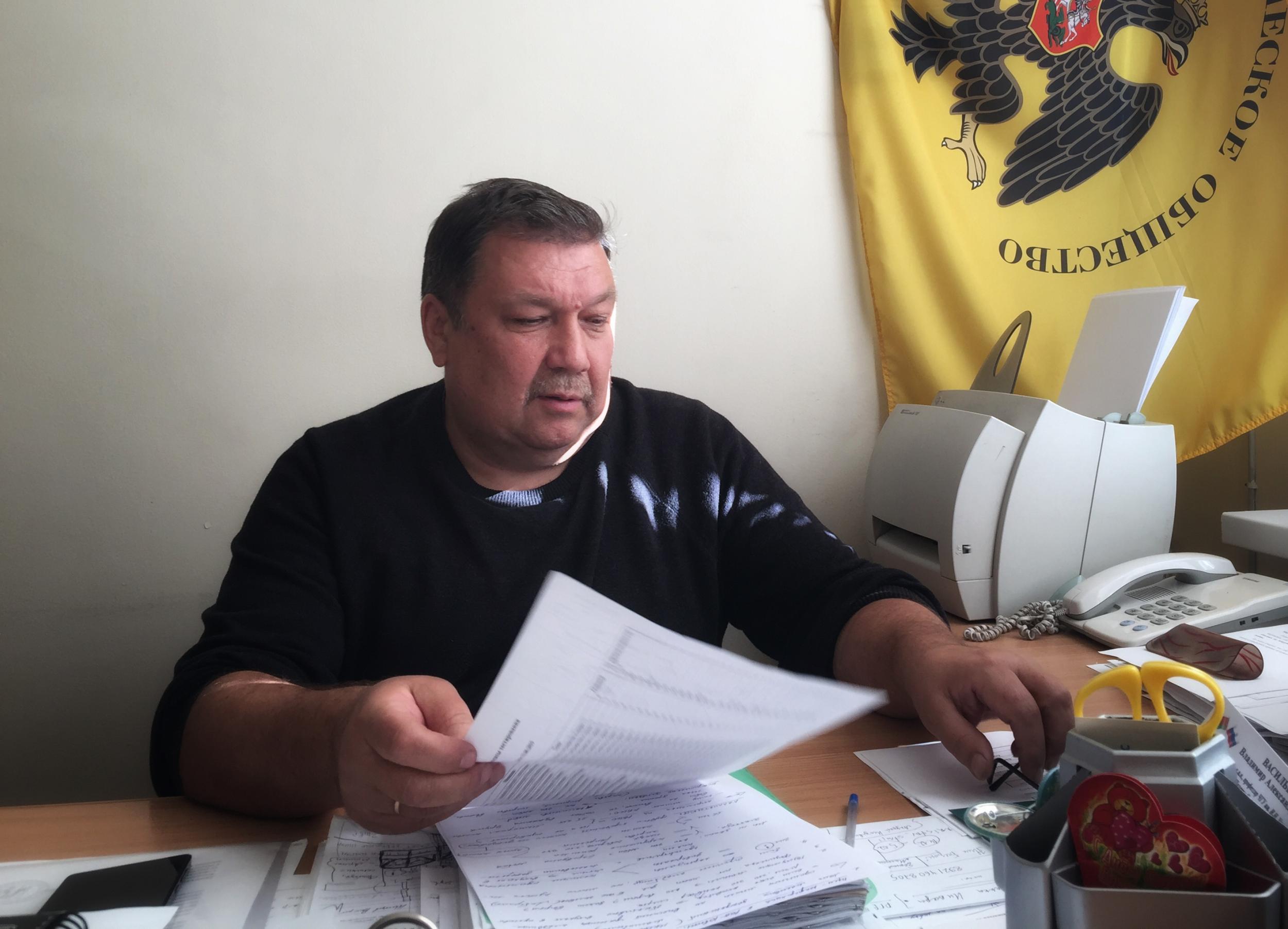Digging up the past: How a Stalin-era mass grave became a battleground in Russia’s memory war
Controversial, state-sponsored excavations are looking to tilt responsibility for Great Terror deaths to the Finnish military


By 17 August, day seven of a nine-day excavation, the diggers bagged up the last of sixteen skeletons, before handing their grim discoveries to the local state investigator, a man clearly more used to fresher homicide evidence.
Above the 10 rectangular pits they had hacked towered the beautiful, tall pine trees that are typical of the local Karelian forest. Below, just a few metres away from the newly exhumed earth, were the wooden crosses, flowers and dropped rectangular hollows that are typical of a mass grave.
A total of 6,241 victims are believed to have been shot and buried here during 1937-38, at the height of the Stalinist Terror. For decades, the site and the deaths it concealed remained a state secret. The full truth emerged only in the 1990s, thanks to a brief opening of the Soviet Union’s NKVD secret police archives and the Herculean efforts of activist researchers.
Only then was the mass grave was given a name – Sandarmokh – and a monumental slab erected at its entrance. “People! Don’t kill one another,” reads the simple message. From its opening to the public in 1997, the atmospheric site has served as a solemn memorial for relatives to mourn their dead.
Until, that is, the patriotic diggers arrived.
The excavation team, led by a Kremlin-sponsored organisation called the Russian Military-Historical Society (RVIO), came with a specific point to prove: That the bones belonged not to the victims of Soviet repressions, or at least not only, but Soviet soldiers, imprisoned and shot by the Finnish military while the territory was under occupation in 1942-44.
There is not a great deal of proof linking the Finns to executions at Sandarmokh, in stark contrast to the documentation of Josef Stalin’s victims. The diggers instead base themselves on loose theories put forward by two controversial local historians, Sergei Verigin and Yury Kilin. The general shape of Verigin and Kilin’s reasoning is thus: if the Finns used the same camps to house Soviet POWs, what was stopping them from executing at the same place the Soviets did?
At a press conference at Sandarmokh, Sergei Barinov, head of the RVIO digging group, refuted accusations that his team had arrived with the aim of whitewashing history. On the contrary, he said, his men had been invited by the local culture ministry “to test a historical hypothesis.” To prove his point, he held up a letter written by deputy minister Sergei Soloviev.
But the text of the letter, hastily photographed by Yelena Kondrakhina, an observer from the Memorial Human Rights organisation, revealed more than was intended.
Stalinist repression was being “used by foreign powers” for propaganda against Russia, the letter read. “Speculation around the events in the Sandarmokh clearing … damages the international image of Russia … and becomes a consolidating factor of anti-government forces.”
The revelation of the state’s position came as little surprise to activists and historians, who say authorities are testing Sandarmokh as a battleground in Russia’s memory war.
Irina Flige, one of three researchers who triangulated their way to the mass burial site in the 1990s, told The Independent that she had witnessed the gradual normalisation of “crazy,” “marginal” and “primitive” theories about Sandarmokh.
“What is happening now is the criminal vandalism at a cemetery,” she said. “These idiots are not only destroying valuable historical information. They are digging up bodies that have children and grandchildren.”

The disruption left behind by the diggers certainly stands in contrast to the detective mastery that brought Flige and her fellow researchers to the eventual burial spot near the northern shore of Lake Onega.
The first piece in the jigsaw came during perestroika in 1989 when a local newspaper in Leningrad published newly declassified execution lists. On close analysis, Flige and her colleagues noticed a spike of 1,000 deaths around the beginning of November 1937. This, they assumed, was the result of a targeted operation.
That theory was confirmed by a separate NKVD document from 1937 showing an execution order for 1825 inmates of the infamous Solovetsky Island corrective camp in the Russian far north. The Solovetsky executions happened in three waves; the first 1,111 ended in up Sandarmokh.
Over 1937-38, the “site near Bear Mountain,” as Sandarmokh was referred to in secret documents, became a regular destination for other victims of Stalinist terror.
As was often the case, Stalin’s executioners later began to devour their own. NKVD Captain Mikhail Matveyev, the man in charge of Sandarmokh’s dark operations, was himself arrested in 1939 on charges of abusing authority. Two of his underlings were executed.

But Matveyev’s interrogation testimony was to provide the next key piece of the jigsaw.
It offered several important revelations about Sandarmokh and the execution protocols. It described how victims were driven up to the pits and led one by one to their deaths; how the victim was first ordered to lie face down in the pit, and then shot with a revolver at point-blank range; and how Captain Matveyev implemented many of the executions – sometimes as many as 400 a day – himself.
Matveyev also gave researchers their main clues about where to find the graves. His testimony referred to the rough distance from Medvezhegorsk – 17 kilometres (11 miles) – and the rough direction (the road westwards to Povenets).
Flige was part of the team that began scouring the Karelian forests, though it was her colleague, Yuri Dmitriyev, who discovered first the tell-tale rectangular hollows in 1997. Almost in the first dig, Dmitriyev’s excavations revealed a bullet-pierced skull. A state prosecutor concurred that Sandarmokh concealed a mass burial site later that year.
State policy to Sandarmokh has changed markedly over the years. Initially, local government was instrumental in opening the memorial complex. It sent high-level delegations to memorial events held annually on the anniversary of the start of Stalin’s Great Terror. It covered organisational costs, published memorial books, and even paid for coaches for international delegations.
But in 2014, following the annexation of Crimea, a new reality emerged in Karelia.
First, Ukrainian delegations, previously active members of the August memorial event, were no longer invited. The following year, Dmitriyev’s speech was cut short by officials. From 2016 onwards, the state began to ignore the events completely.
In December 2016, Yury Dmitriyev was himself arrested on wild but contested child pornography charges. The accusation was serious but friends and colleagues called foul, suggesting the charges were connected to his activism. In April 2018, a judge agreed, and acquitted him – against all expectations. But authorities fought back with an appeal that was ultimately successful and Dmitriyev’s freedom lasted only a week. He awaits a second trial.
It was around the time of Dmitriyev’s first arrest that the Finnish theories of Sergei Veregin and Yury Kilin began to gain real traction.

Irina Galkova, a representative of the Moscow branch of the Memorial human rights organisation, recalls a 2017 conference organised by Veregin in Petrozavodsk. She says she was struck by the number of grey suits sitting among a room of academics; these were the official historians of Russia’s security agency (FSB) and military academies. The conference was the first time she heard about Veregin’s Red Army theory.
“The local academics were angry by what they heard, but we just didn’t get it,” she says. “We thought this person was an idiot who knew nothing. Sadly, he perhaps knew too much.”
During an interview in his office in Petrozavodsk University, Sergei Veregin denied any improper links with security services or the authorities. Of course, he said, like any good historian he “depended” on access to state archives, but that was the limit of his interaction with the security services. He stood by the body of his work, which “often” touched “sensitive” topics for the Russian state.
The academic offered a careful defence of his controversial Sandarmokh theory. It was not his business to deny political repression at Sandarmokh, he said. The graves “most likely” did contain victims of Stalinist terror. But almost in the next sentence came an explicit denial of the scale of that terror. More than half the pits were “empty.” There was “no way” the grounds contained 6,500 bodies. Facts had become “politicised.” Death – “exaggerated.”
The western media was “plying an information war” against Russia, Veregin said: “There should be no white blanks in history. It’s wrong that activists have monopolised Sandarmokh, with no right of any other opinion.”
At Sandarmokh, a few days after the diggers had upped tools and filled in the pits, the flow of visitors had returned. Some of them were tourists. They came equipped with cameras, books and smartphones.
Others arrived with flowers and an altogether heavier burden.
“I’m visiting granddad,” said Petr Nazarov, 65. “He was arrested, like they all were, in the middle of the night, taken in a black car by NKVD officers in November 1937.”
Mikhail Nazarov, director of the local collective farm, Petr’s granddad, stood accused of taking part in an organised coup against the Soviet state. He was found guilty by a Troika commission, and shot at Sandarmokh, on March 1938.
“I don’t see how there can be any argument or information war,“ Petr Nazarov says. “Repentance. That’s all we should be thinking about.”
Join our commenting forum
Join thought-provoking conversations, follow other Independent readers and see their replies
Comments
Bookmark popover
Removed from bookmarks